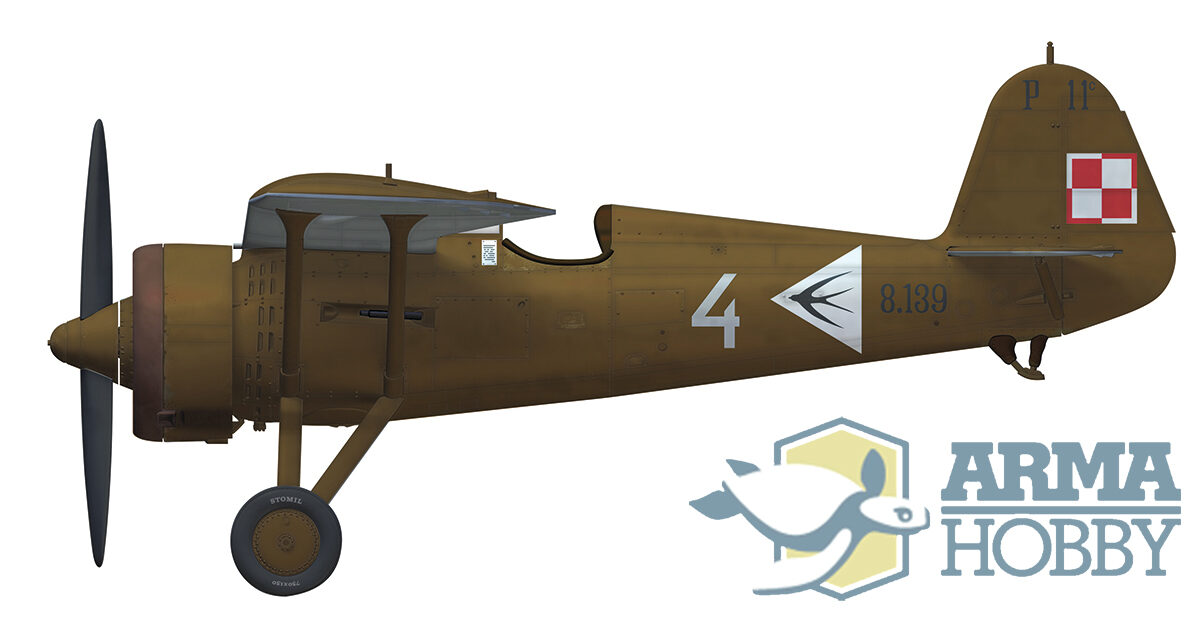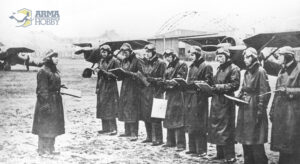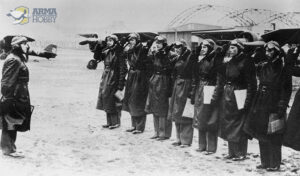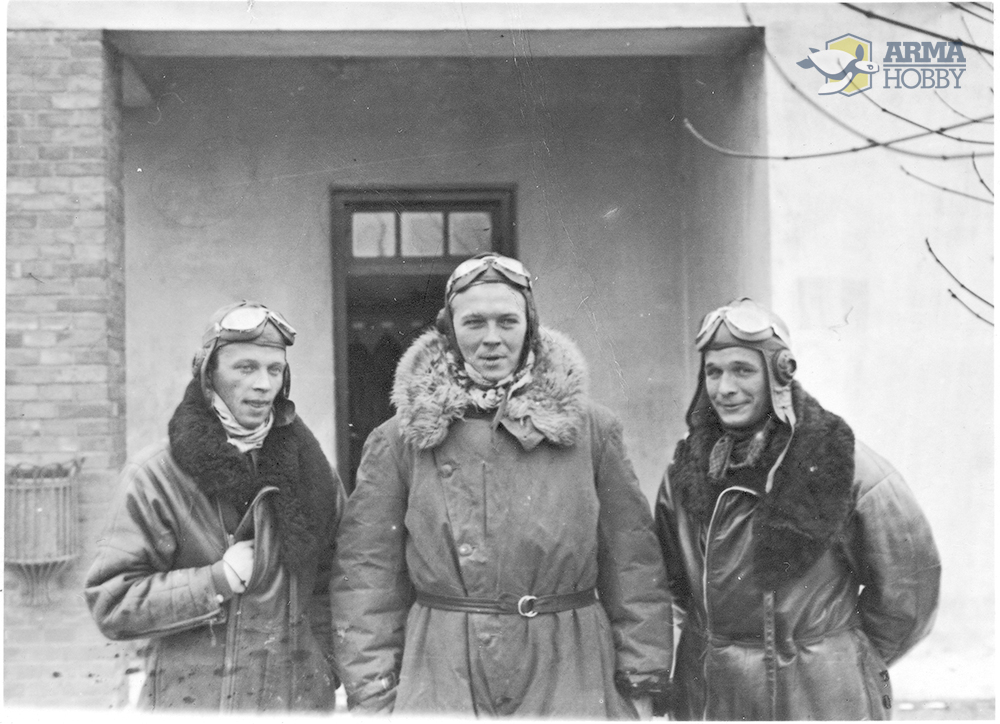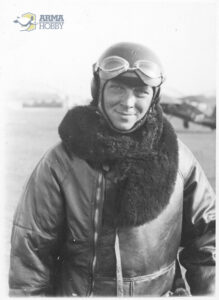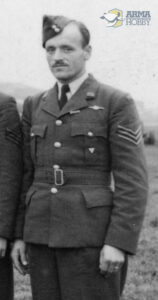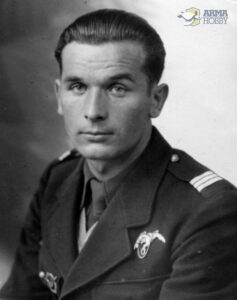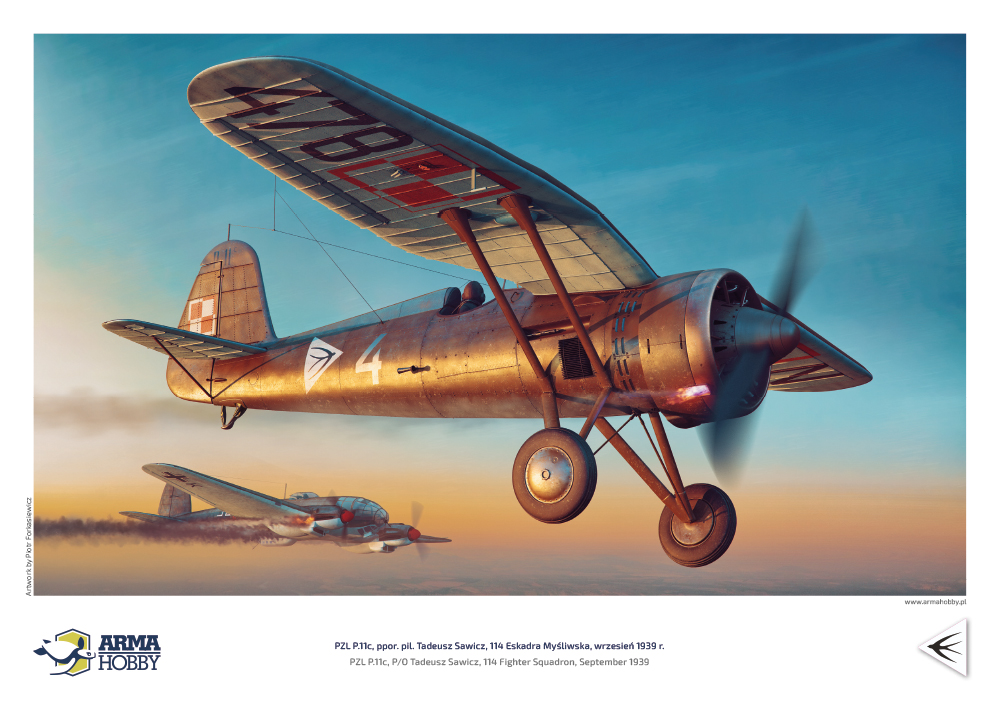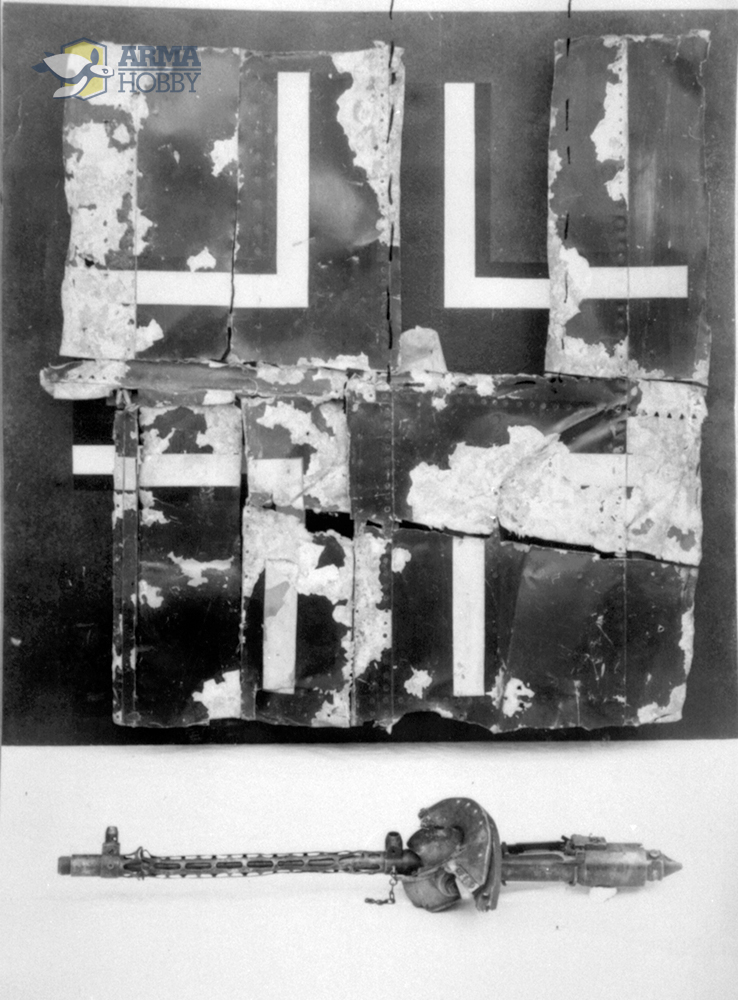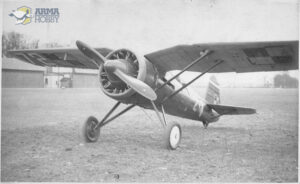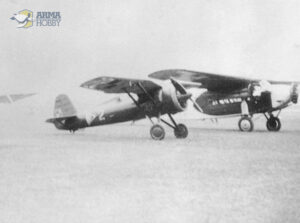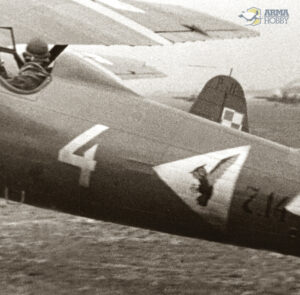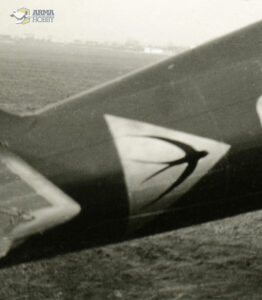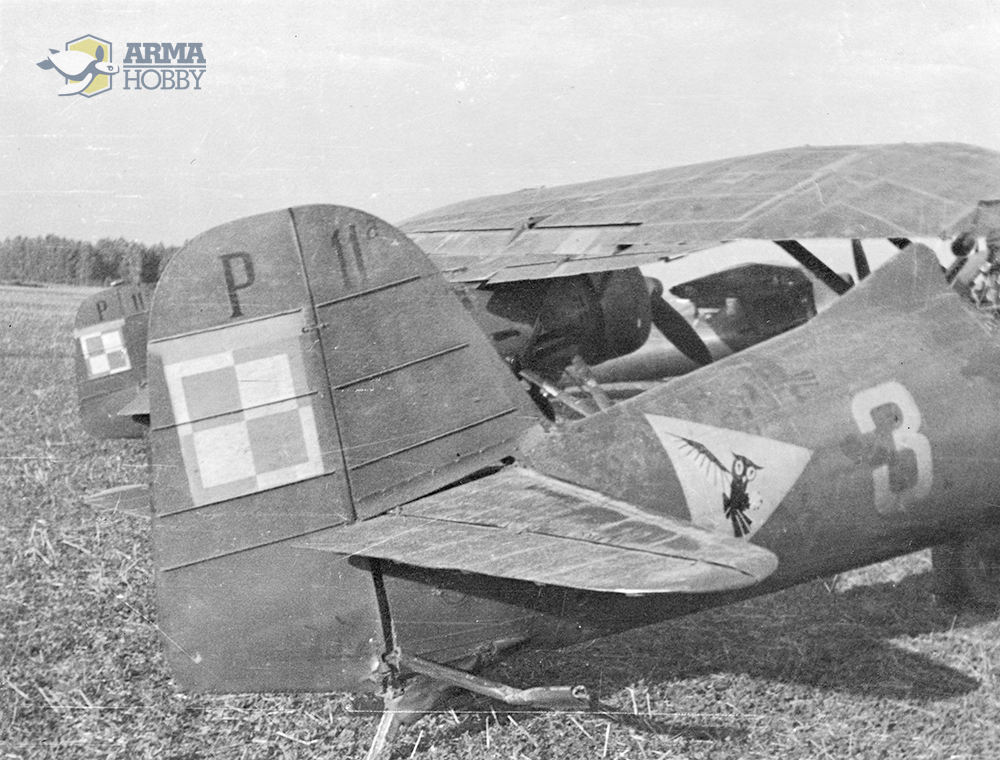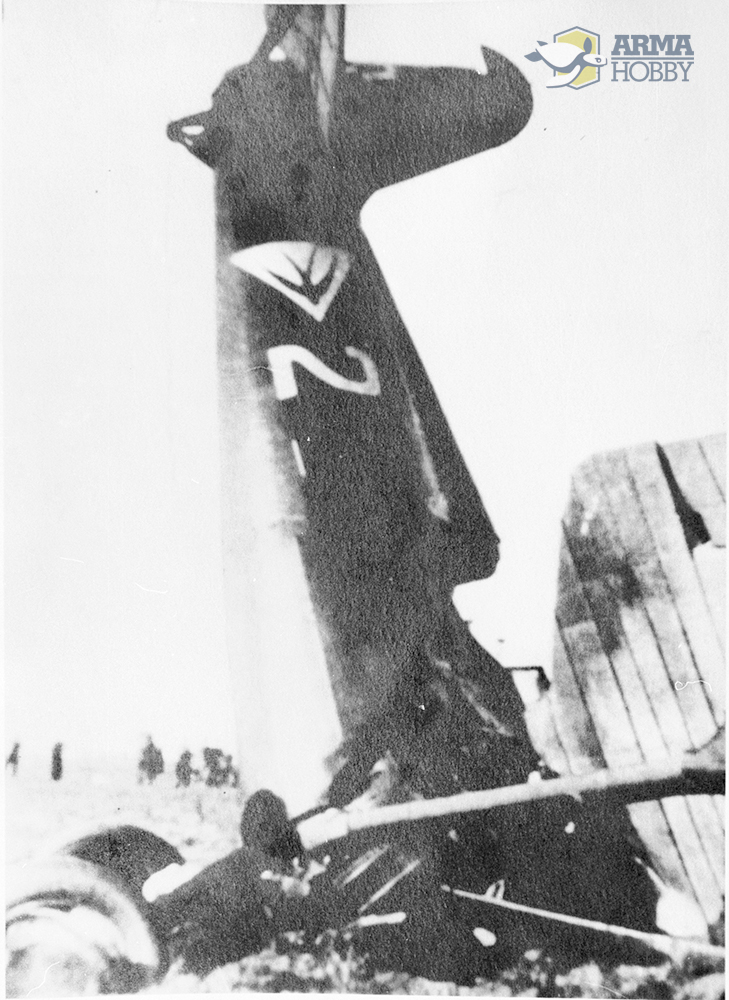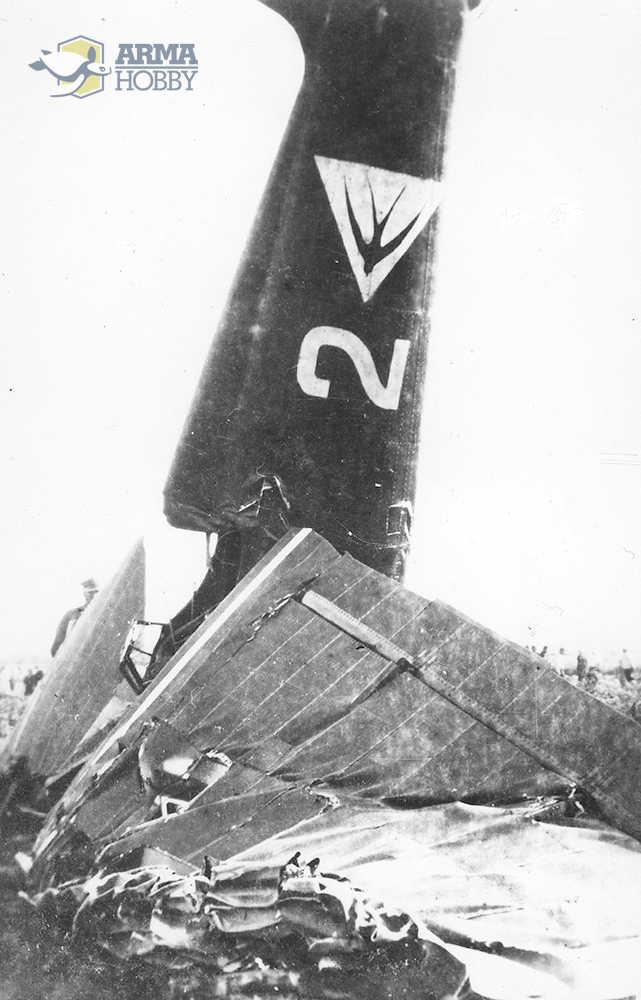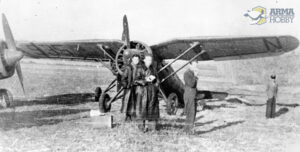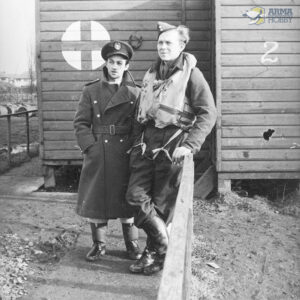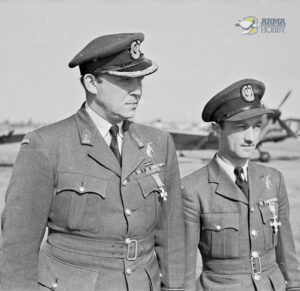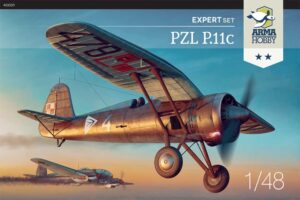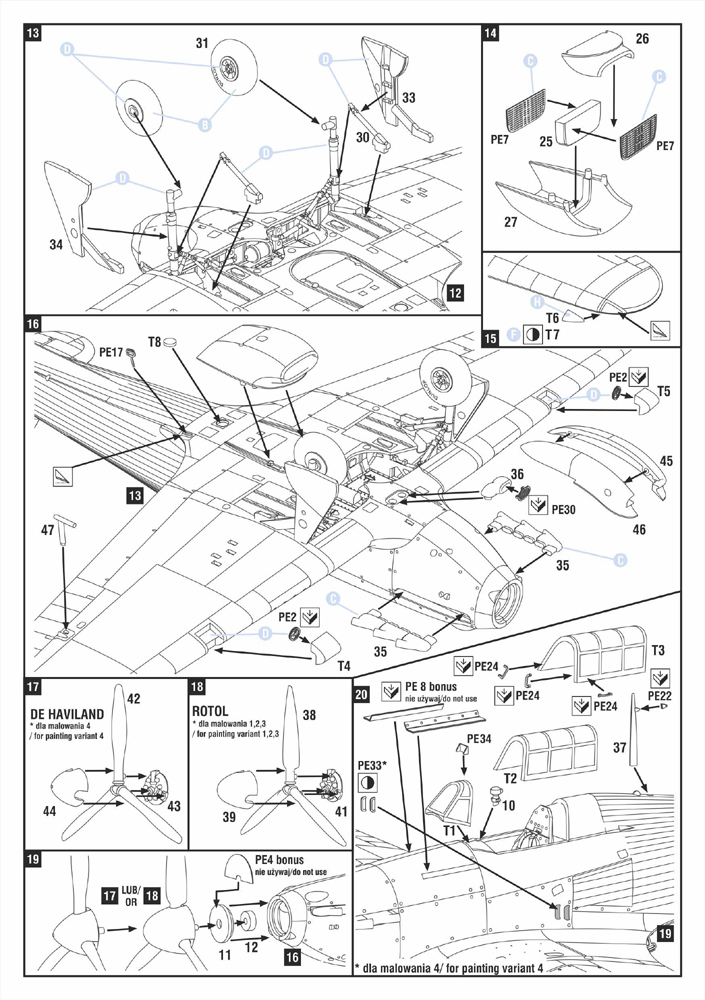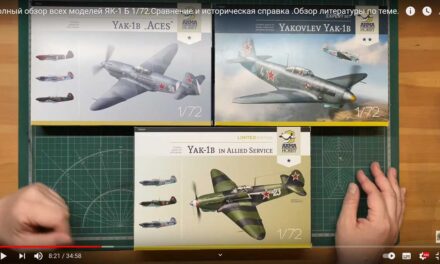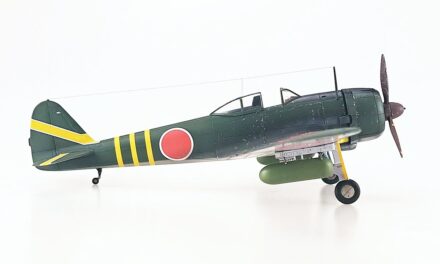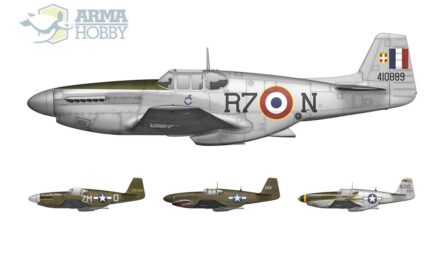Tracing the day-by-day fate of individual aeroplanes during the 1939 air operations over Poland is not possible, due to incomplete surviving documents. When trying to recreate the story of a specific aircraft, we must rely on fragmentary surviving documents and on the accounts of veterans. This is the case with the PZL P.11c marked with the ‘Swallow’ emblem of the 114th Fighter Flight (114 Eskadra Myśliwska) of the IV/1 Fighter Squadron (IV/1 Dywizjon Myśliwski) from the Warsaw-based 1st Air Regiment (1 Pułk Lotniczy), and with code number 4. Perhaps one day documents will come to light that will allow verification of the numbers and markings on aircraft flown by individual airmen during specific sorties. But perhaps this will forever be a subject of guesswork and argument?…
Two frequently published photos from an exercise in the spring of 1939. P.11s of the 113th Fighter Flight can be seen in the background. The aircraft at far right is no. 8.70 ‘Owl 10’ with a white under-wing number 70. The presence of 113th Flight aircraft in the photo has misled some authors to link the pilots visible in the photo with that unit. In fact, however, they are from the 114th Flight. Its commander, Capt. J. Frey, is standing at far left in the line, Lt A. Gabszewicz is next to him, 2nd Lt W. Klawe is fifth, and 2nd Lt T. Sawicz seventh. The briefing is led by Cpt. A. Kowalczyk, commanding the IV/1 Fighter Squadron. They are all wearing standard air force leather coats, soft flying helmets, and goggles.
Before the war, ‘Swallow no. 4’ was usually flown by 2nd Lt Tadeusz Sawicz. He was a section leader in this flight and when the war broke out he was at the forward airfield at Poniatów near Warsaw with the entire 114th Flight. Along with other Warsaw fighter flights, it became part of the Pursuit Brigade (Brygada Pościgowa), whose task was to defend the skies over Poland’s capital city. However, on the morning of 1 September 1939, he was not given an opportunity to take part in air combat in defence of Warsaw. Some accounts say that Sawicz left to collect the pay for the staff. However, according to his own recollections, the news that the war had just broken out found him at the airfield, under the wing of his P.11c ‘Swallow no. 4’. Soon after that, he was given the task of going to Warsaw to bring the 123rd Fighter Flight (from the Cracow-based 2nd Air Regiment), which was also part of the Pursuit Brigade. On 1 September morning, the 123rd Flight was at the Okęcie air base and, faced with the threat of German air raids, it had to be brought to the camouflaged airstrip as quickly as possible. An air raid alert was in progress in the city as Sawicz was driving across Vistula on Kierbedzia bridge near the Royal Castle. At this time his colleagues must have already been on their way to meet the German aircraft in the air.
Three pilots of the 114th Flight, left to right: 2nd Lt Marian Szalewicz, Lt Aleksander Gabszewicz and Cpl. Andrzej Niewiara, in fur-lined flying suits. Gabszewicz is wearing a fabric one, while Szalewicz and Niewiara have leather ones of two different types. All wear soft leather helmets and flying goggles.
Photos from the left:
- Lt Aleksander Gabszewicz in a leather flying suit. A P.11 from the 114th Flight can be seen in the background. The pilot is wearing the 1938 pattern headgear as used by pilots of radio-equipped aeroplanes. Fighter pilots were strongly against the introduction of the flying helmet, arguing that it was too large and limited their head movements in the cockpit. The headphones and microphone were often removed and mounted in soft leather helmets.
- Sgt Paweł Kulesza (photographed in 1943 in Britain, where the mechanic continued to have the aeroplanes of Gabszewicz and Sawicz in his care).
- Cpl. Andrzej Niewiara (a later photo). He was killed in air combat on 9 August 1941 while flying with 315 Squadron.
First ‘kill’ over Warsaw
Aleksander Gabszewicz, at the time the tactics officer of the IV/1 Fighter Squadron of the Pursuit Brigade, subsequently wrote down his recollections of the first ‘kill’ scored by the Brigade.
The morning of 1 September 1939. We are based at Poniatów, north of Warsaw. Aeroplanes hidden in the forest. The tent where I have my office as a clerk is between the units on the edge of a grove. I pick up the phone – the HQ calling: “The Germans have crossed the national border near Działdowo at 4:45 am” – I look at my watch, 6:35 am. I lean out of the tent and shout through a tube: “Pilots to machines, wait for the order to scramble.” I look for Adaś [Capt. Adam Kowalczyk, IV/1 Sqn commander – all comments in square brackets by W.M.] and I tell him about this order – he approves. Within five minutes of the first signal, I receive the order: “All Sqn aeroplanes – scramble.”
“Enemy aeroplanes approaching from the direction 11c.”, I repeat the order through the tube. Adaś jumps up, his eyes sparkle, he grabs a balaclava and rushes madly to his P [PZL P.11 fighter]. The Sqn taxies out from its hiding area for take-off in vics of three. The emergency section is off first: Himek [2nd Lt Hieronim Dudwał], Cadet Officer Jurek R. [2nd Lt Jerzy Radomski] and [Lce Sgt Mieczysław] Kaźmierczak. Everything is done smoothly, just like during the training flying at Okęcie. My heart rejoices. The mechanics make a sign of cross to every aeroplane. It’s war! First time! I can see that three aeroplanes are standing still. I recall now that ‘Rat’ [2nd Lt Tadeusz Sawicz] went to Warsaw with orders and therefore his wingmen: Cadet Off. Boguś [2nd Lt Bogusław Mierzwa] and Cpl [Andrzej] Niewiara are waiting obediently until the leading machine starts up.
I decide to take ‘Swallow No. 4’ after sending a signal to the HQ about the squadron scramble. Kulesza, the mechanic of the abandoned ‘4’, turned red with joy that his machine would be baptised, too. They position themselves wing next to wing. Take-off like during a show. We are climbing up. We cut the thin layer of morning mist and go up northwards. We reach an altitude of 1,500 m. Then I see 5 aeroplanes in front of me, some 500 m higher, going in the opposite direction. I was dumbfounded. I can see black crosses on aeroplanes for the first time in my life – maybe a hallucination? I lift the aeroplane up and head towards the crosses. Out of the corner of my eye, I can see that my wingmen’s nerves cannot stand the slow speed and they gradually fall away. I make the deflection. Brrr… brrr… two streams run, shining, to the Huns. Here my machine shivered. Boom… and I’m in a spin. I push the stick, I kick with the opposite foot. The spin stopped, I pull back again to gain the lost height immediately. Too soon – I’m in a spin again – “Old but stupid”, I thought, reproaching myself, “wait for the aeroplane to pick up speed”.
I recover. Another ‘Swallow’ is already beside me – that’s Niewiara. I look around and see five bombers within a short distance. We pull there. We’re getting closer. I recognise the He 111. I look down – Modlin. The closer to Warsaw, the more friendly aeroplanes in the sky. A third machine joins me – that’s Boguś. He knew where to go, rascal.
Closer. Somehow, it’s difficult to get closer. I open fire. Close. Sparkles ran across my wings. It’s only now that I can see red and yellow drops flowing from the German – ah, he’s firing, too. Boguś, seeing that he will not get his turn at shooting, and with Niewiara in front of him, moves to the right to another Heinkel. A strange spectacle – my bullet streaks reach the bomber and disappear inside it, giving a big spark in the final phase. I see a lot of these fires. Everything seems to be happening very slowly, like in slow motion movie. This action must have been going on for 10 minutes. But that’s impossible – I still have ammunition. This whole circus has only been going on for a few seconds.
Suddenly I can see (and I think I can hear) an explosion. Flame and smoke from the Hun’s port engine. It feels as if someone has pulled the reins because my target stays behind. A few seconds later, strange objects detach from the shot-up machine. Bombs! He turns to the port and down. I no longer have trouble catching up. I can see Niewiara all the time. I move slightly to the port and watch. The Heinkel’s gunner still defends himself, but after a while he calms down. I come closer again. The barrel of his gun on the tail sticks up motionless, silent. I get even closer. I can see the gunner, his head resting on the starboard side. The pilot apparently hopes to reach his base, as he makes a 180-degree turn and heads towards East Prussia. We follow him lower and lower. I can clearly see motor vehicles moving on some highway. A moment later we’re hedge-hopping. Both I and Niewiara had run out of ammunition five minutes ago.
A large clearing bounded on three sides by a forest, and on the fourth by the highway. The Heinkel is slowing down, I can’t stay behind him. I see, he has given up getting back and intends to get down straight ahead in the clearing. At the last moment, no more than 2 metres above the ground, he hit a lonely tree with his port wing. Dust and smoke. I pull my PZL up. I look around. The Heinkel’s port wing is broken away, the tree is also down. The fuselage is lying at more than 90 degrees to the landing approach direction. I start circling. I take out my map because I have to find out where I am. I know that I am north of Bugo-Narew. Finally, I realise that I am south of Ciechanów. I mark the place on the map where the aeroplane is with my fingernail. I return. I’m glad. I land at the airstrip. Kulesza runs up and tries to shout over the hum of the engine: “take off – heading 16”. Without switching off the engine, I wait a few minutes for Struczak to rearm my aircraft. Another scramble. I can see that some ‘Owl’ [113th Flight aeroplane] is also taking off. After a short while, he joins me. We are heading towards Zielonka.
One smoking German heading through the sky, with five of our fighters on its tail. There is nothing else to do here. I’m circling for 15 minutes. Then a twin-engined aeroplane is going in the same direction to my port. Full throttle – we’re getting closer, I recognise that it’s not a Heinkel. Ah, it’s the Dornier (called Bleischift) [“Bleistift” or “pencil”, Dornier 17 aeroplanes were popularly called “Flying pencils” due to their long and narrow fuselage]. He has spotted us, I open fire. Something strange – the bomber starts diving, I follow. Somehow the distance between us has not decreased. I apply the boost and still fall behind. 1,000 m. 1,500 m. It begins to fade away against the ground. “This is some new aeroplane”, I thought. It later turned out that the Germans had more of these new aeroplanes than the old ones. [Of course it must have been the Messerschmitt 110.]
‘We’re going back to the airfield. Almost all aeroplanes have already landed, because about 2 hours have passed since the first scramble. As I taxi, I can see that some of the P.11s have not yet been drawn into their hiding places. Kulesza gives the sign “turn off.” “Sir, you’ve been shot, too.” I look, yes, I have a few bullet holes. I do not have the time to rummage in the aeroplane, because the mechanics are jumping around, refuelling and rearming.
(Quoted from an account published in: “Skrzydła. Opowiadania lotnicze”, Wydawnictwo Polskiego Ośrodka Kulturalno-Artystycznego, Hannover, 1946. Note that numerous publications have copied this account with a lot of alterations.)
Parts of He 111 L1+KN from the 5./LG 1. The sheet of metal with the black cross was kept in hiding by the pilot’s relatives throughout the German occupation and that is why it was folded. Currently, these items are at the Polish Army Museum in Warsaw.
Gabszewicz and Niewiara probably downed He 111 L1 + KN from 5./LG 1, which crash-landed and broke in two near the village of Mieszki-Kuligi. According to German data, the aeroplane was lost in the Modlin area around 9:00. This time does not match the account quoted above, but is consistent with the “Report on activities for 1 September until 4.00 pm ”of the Pursuit Brigade: ‘At 8.50 am the enemy flew a raid on Warsaw from the north’ [quoted from J. B. Cynk, “Polskie lotnictwo myśliwskie w boju wrześniowym”; AJ-Press, Gdańsk 2000] After Sawicz returned, Gabszewicz scrambled in the afternoon in P.11 ‘Swallow no. 8’. During that sortie he was shot down and had to bale out.
Two photos of PZL P.11c no. 2 from the 114th Flight. Note the pale (probably white) under-wing number 72. The letter N in the same colour was probably applied on the lower surface of the port wing. In 1939, black three-digit under-wing numbers were introduced when aeroplanes of the Pursuit Brigade were repainted.
The aeroplane has a pale (blue or white?) stripe on the port side of the tail and the port wing, and the cap of the port wheel in the same colour. According to the accounts that are difficult to verify, this was the marking of the port section of the flight.
PZL P.11c ‘Swallow no. 4’
PZL P.11c no. 4 (serial no. 8.139 and buzz no. 478-N are both speculative, the latter may also have been 178-N). According to recent research, the aeroplane had earlier had the under-wing number 78-N. The aeroplane was equipped with the radio, armed with 2 machine guns and fitted with night flying lights on the wings and on top of the fuselage behind the cockpit. 114th Flight, IV/1 Squadron, Pursuit Brigade. Pilot, 2nd Lt Tadeusz Sawicz (2 ‘kills’ in this aeroplane). On 1 September 1939, flying from Poniatów near Warsaw, Lt Aleksander Gabszewicz scored the first aerial victory in defence of Warsaw. Artwork by Zbyszek Malicki.
The black three-digit sub-wing (so-called police) number, introduced in the summer of 1939, probably in connection with mobilization.
NOTE: According to an interview with Tadeusz Sawicz on 28 August 2002, the flight emblem should have white background – this differs from the form of the emblem usually featured in colour profiles. Analysis of original photos does not allow ascertaining whether it was white or light blue. Interestingly, the badges worn on the uniform by members of the 114th Flight were made in two variants: with white background and a dark blue swallow or with pale blue background and a black swallow, the swallow motif also differed slightly.
P.11a serial no. 7.14 from the 113th Flight with the code no. 4. This was the standard style of the digit used in code numbers of 1st Air Regiment fighters. Close-up of the flight emblem on a P.11c from the 114th Fighter Flight. Photos from T. Kopański collection.
The ‘Owl’ emblem of the 113th Flight, as mentioned in the text, seen on a P.11a of the unit. Note that the triangular background is not white, in this black-and-white photo it seems darker than the yellow elements of the bird motif.
Trip to besieged Warsaw
Although the first victory at the controls of the PZL P. 11c ‘Swallow no. 4’ was scored by Aleksander Gabszewicz, this aeroplane was usually flown by 2nd Lt Tadeusz Sawicz from the 114th Fighter Flight, as already mentioned. He started the war as a section leader, and after Lt Jerzy Szałowski was shot down on 4 September, he became the deputy flight commander, vice Capt. Juliusz Frey. According to the official listing, Sawicz was credited with two German aeroplanes destroyed and one shared damaged in September 1939. However, during his most dramatic flight of the entire campaign, the pilot did not engage the enemy in the air…
This is his account.
…On 14 September, I was summoned to the HQ of the Supreme Commander, where I was handed the orders of Marshal Rydz-Śmigły to be delivered to General Rómmel, surrounded by the Germans in Warsaw, and to bring a reply back. Upon receiving the envelope with orders and information that I should stick to the right [east] side of the Vistula, because the suburbs of Warsaw were already occupied by the Germans, I took off. The Germans shot at me en route, but not very accurately. Visibility was poor and, not wanting to get lost, I landed in a field not far from Warsaw to find out what the frontline situation was and from which side I should be arriving in the city, so as not to be shot down during landing. I alighted in the field bouncing on rough ground, and looked around. After a few minutes, a nervous farmer ran up to me.
Depart immediately, because the town is occupied by the Germans’, he kept repeating, visibly shaken. “What place is this?” “Siedlce”, replied the farmer.
I took off immediately and a moment later flew over a column of marching Germans. Apparently they did not think that a Polish aeroplane might be flying over them, because they did not shoot at me.
Arriving over Warsaw, obscured by smoke, I began to wonder about how to approach the city, the defenders of which, and the Germans alike, could take my aeroplane for an enemy and shoot it down…
I had no idea where the Polish defence lines were and where the German lines were. I hedge-hopped all the time, ‘jumping over’ any obstacles I encountered, in order not to give either friendly or enemy troops enough time to aim at me and open effective fire. I don’t know why, but I was afraid to fly over Okęcie. When I arrived over Mokotów, I saw a lot of trenches across the field. I didn’t even think they were German lines, and I came down to land. I descended flying low over the German trenches, but no-one was shooting at me, because they had apparently mistaken me for one of theirs. The airfield was full of trenches and bomb craters, but I managed to land successfully. I haven’t even gotten out of my machine yet, when the Germans started firing at me. With the help of some approaching people, I pulled the aeroplane away from the zone of fire and hid behind a demolished building. It was damaged by a few accurate shells. Our soldiers ran up to me and checked my identity. Once they learned that I was a Polish pilot bringing orders to General Rómmel, I was taken to his quarters. It was located in shelters at Rakowiecka Street. In the bunker, apart from General Rómmel, there was Col. Iżycki and several senior officers, who informed me during the conversation that if I had landed at Okęcie rather than the Mokotów airfield, the Germans would have taken me prisoner.
Having read the orders I had brought, General Rómmel called his staff for a conference, and I was ordered to leave. I used the free moment and ran to see my mother. Several hours had elapsed when I was summoned to report immediately to the HQ. It was night already. I reported to Gen. Rómmel and received a reply to deliver to Marshal Śmigły and a lot of cigarettes.
‘“Is anyone coming with me?”, I asked. General Rómmel replied that I would find out later, once the aeroplane was ready to take off. I was dismissed and left. We repaired the damaged aeroplane in a street. After refuelling, I walked around the airfield to see how I should take off to avoid falling into a pit. The Germans were shooting at me, but light mist shielded me from them and the bullets missed. We started up the aeroplane. An officer standing near told me that no-one would come with me.
I taxied to take off. The Germans, who had been firing at us since the aeroplane’s engine started, doubled their fire. Bouncing along the narrow strip of field between craters, I gave full throttle, lifted the machine off with the controls and went up, flying straight onto the German trenches. The bullets were passing my aeroplane within metres. With a sharp turn I left the zone of fire and returned over the city in hedge-hopping flight, over the positions in which our soldiers lay. Seeing the incoming aeroplane, they rolled onto their backs and shot at me. They could not imagine that any other aeroplane could be flying here but German. I flew into the smoke over the city. German rounds flashed to the port and starboard, exploding in the streets and between houses. I saw a crowd of people who, seeing the aeroplane flying over the rooftops, were simply trampling each other in a panic escape.
Glow and smoke everywhere. Shot at by our own soldiers, dodging the bullets, I headed towards the burning Praga suburb. While flying across the Vistula, I passed a flight of German bombers. They flew in majestic formation over the burning city. Their crews did not see me or did not think that any Polish aeroplane could still be flying over Warsaw. I ‘jumped’ across the Vistula. Praga seemed to be one great fire site, covered with smoke through which the blood-coloured fires of exploding rounds flashed. Fighting took place on the outskirts of the burning city. Judging by the intensity of the fire, the Germans had a great advantage over the Polish defences, towards which an avalanche of armoured vehicles was moving. Our soldiers sat in shallow ditches, waiting for the attack. I could not help them…
Still shot at from the ground, I headed south, speeding with all the power from my trembling engine. The heroic Warsaw, obscured by the smoke and the glow of fires, disappeared on the horizon… I took off the sweaty scarf from my neck and was no longer surprised that no-one had joined me for the flight…
(Account published in: “Stolica” No. 40/1958; quoted from: J. Pawlak ” Brygada Pościgowa: alarm!”; Wydawnictwo MON, Warsaw 1977)
More photos of P.11c no. 2 from the 114th Flight, probably the same as in the previous images. The photos were taken after the tragic accident on 7 June 1939, in which Cpr. Antoni Gogolok was killed. Note the standard shape and arrangement of flight markings on the fuselage. The bottom of the fuselage was not in a pale colour as might appear, it was just illuminated by the evening sun.
Soon the thickening fog forced him to land at a random place. Soldiers stationed there initially mistook him for an enemy, but a young officer correctly recognised the nationality of the pilot. Following a breakfast, hastily organized by the local people, Sawicz set off in search of his unit.
When I arrived at Młynów, it was already empty. The Brigade had moved on and I didn’t know where to. If I had fuel I would have gone further south and keep cruising around looking for them. But I had no petrol and I didn’t know what to do next. I sat under the wing of my aeroplane and waited for God’s mercy. The landing field was on a high ground and there was a road below. On this road, in the distance, I saw a cloud of dust, some movement. After a while, it became apparent that it was a column of trucks. I looked closely and soon saw that it was the air force. It turned out that it was a group under Maj. [Franciszek] Ratajczak, commander of the Air Base of the 1st Regiment. He was glad to see me and said that they would give me petrol, but I had to fly to Polesie, where the Łoś aircraft of the Bomber Brigade were hidden. I am to deliver them the orders to come here to Młynów. I replied that I had a report from Warsaw for the Supreme Commander, I can’t go anywhere, just take the shortest route to the HQ. So we started haggling and I finally gave in. Maj. Ratajczak gave me his word of honour that he would personally deliver the reports to the Supreme Commander. He showed me on the map where the Łoś bombers were and stressed that it was right next to a railway line. Just as well that he emphasised this because they were so perfectly camouflaged that I would never have found them. On the way, I saw the town of Ołyka. It burned like hell. When I reached the area indicated by Major Ratajczak, I kept flying back and forth but I could not see anything. Eventually I descended along the railway line right above the ground. There was nothing visible on one side, so I flew over to the other side of that line. And finally I spotted a machine gun position. It was covered from above with a straw roof, just like haystack. When I noticed that, I knew it was somewhere round here and finally found our men. I landed, and immediately afterwards two German bombers flew over the airstrip. I look around, but my aeroplane is gone. They were so well camouflaged that as soon as I got out my aeroplane was hidden somewhere among the trees. I gave them the orders, I showed how to get to Młynów, and after refuelling I flew south to look for my unit. I was circling and finally noticed three army trucks under trees. I went down and recognised that they were airmen. So I landed there and it turned out that I found my mechanics, from the Flight. Their chief, his name was [Sgt Józef] Rajca, told me where the Brigade was and I joined it there. And two days later, we had to fly to Romania.
(Tadeusz Sawicz, interview in Warsaw, August/September 2002)
The aeroplanes of the Pursuit Brigade at the Młynów airfield in south-eastern Poland. The unit emblems and code numbers have been painted over. It is noteworthy that the under-wing number 935 was so wide that the Polish national marking was repositioned closer to the wing struts. The national marking on the other wing has been obliterated, but the letter N was retained.
‘Sikorski’s tourists’: Polish airmen from the IV/1 Fighter Squadron of the Pursuit Brigade photographed in Romania in September 1939, already in civvies, ready to go to France. Left to right: Hieronim Dudwał (one of top-scoring Polish fighters of the 1939 campaign, he was killed in France in June 1940), Tadeusz Sawicz, Jerzy Czerniak (killed over France in 1941 with 315 Squadron) and Włodzimierz Klawe (flew in combat in France and Britain).
‘Swallow no. 4’ was then taken over by the Romanian Air Force.
According to data from Romania, 2nd Lt Sawicz arrived in PZL P.11c no. 8.139. All the P.11s taken over by the Romanian Air Force were distributed among the P.11f units and training establishments. They took part in ‘Operation Barbarossa’, the invasion of the USSR. No. 8.139 received the Romanian number 323 and was used at the Şcoala de Ofiţeri de Aviaţie (Air Force Officers School) at Călăraşi during 1942–1943. It was struck off charge on 8 January 1946 due to wear.
The combat careers of these two pilots were connected throughout the war:
Gabszewicz as 316 Sqn commander and Sawicz as ‘A’ Flight commander in that squadron in the spring of 1942…
…Gabszewicz as Officer Commanding No. 131 Wing of the BAFO and Sawicz as the Wing Commander Flying of this Wing during a decoration ceremony in the summer of 1945 in allied-occupied Germany.
You may be interested in::
- Buy 40001 PZL P.11c Expert Set 1/48 and more in Arma Hobby webstore!
Aircraft engineer by education, translator by trade. Author/co-author of over 50 books on the history of (mostly Polish) aviation, published in various countries and languages, including a biography of Tadeusz Sawicz, a number of biographical dictionaries, the fundamental Historia lotnictwa w Polsce (History of Aviation in Poland), and the first complete history of 303 Squadron.
This post is also available in:
 polski
polski


